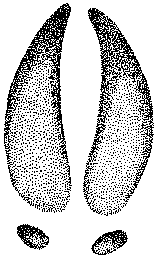By the end of the 1800’s, there were fewer than 20 white-tailed deer in all of Connecticut. Their near extinction locally was the result of uncontrolled hunting and habitat loss, as forests were cleared and then farm fields were abandoned.
 |
Deer tracks are heart-shaped, with pointed toes. Dew claws may show when deer run through mud or snow. Bounds are 10-15 feet apart. |
Today you might see more than 20 deer in one square mile. In the year 2000, there were about 76,350 deer in CT – more than triple the number found in the 1970s. The deer population is increasing in parallel with an increase in residential areas not suitable for hunting; forests with a mix of young and mature growth; milder winters; and reduced or non-existent predator populations.
White-tailed deer are now common in forests, fields, and wetlands. Deer usually don’t migrate, generally staying within about a one mile range. Only males have antlers, which drop off mid-December to late-January. The healthiest males with the best genes have the biggest antlers. Males are bigger than females – averaging 150 lbs. Females are usually about 110 lbs. Mating season peaks the last two weeks of Nov, but can last from late Oct-early January. When males are focused on chasing females, they may be more likely to end up on your windshield. If you see a deer near or on the road at night, always slow down or brake, because others are typically not far behind.
Fawns (usually twins, and sometimes triplets or even quadruplets) are born in June. To avoid attracting predators, the mother only visits them 3-4 times a day for about 15 minutes to feed them. Thus, a fawn alone in the woods doesn’t mean it’s abandoned. Fawns lose their white spots around the end of August.
Depending on the season and what’s available, deer eat grass; lichens or moss; seedlings, young trees and buds; acorns, and apples. They avoid plants with thorny stems, prickly leaves, and strong aromas. However, a really hungry deer will eat just about anything. In fact, researchers monitoring bird nests with video cameras even caught them eating ground-nesting bird babies. Unfortunately deer don’t like to eat some non-native invasive plants like Japanese Barberry and Asian bittersweet, which gives those aggressive plants an even better shot at taking over the landscape.
Deer overpopulation can affect animal and human health (e.g., animal starvation or disease, Lyme disease from deer ticks, and collision injuries), and result in property damage (to cars, landscaping, farm crops and forests.) Selective feeding and overbrowsing can dramatically change the landscape. Forest health and wildlife diversity, including wildflower and grassland songbird populations, suffer as a result.
Deer management focuses on maintaining populations at a sustainable level (about 10-30 deer/square mile), in balance with the rest of the ecosystem. Birth control has been tried in areas like Fire Island, but has proven costly, labor-intensive, and not very effective. Hunting is the most effective means of controlling local populations. According to the CT DEP, farmers experiencing deer damage problems would be wise to encourage hunting on their property during the regulated deer seasons. Regulated hunting (tax on gun sales and ammo, and hunting license fees) also funds many wildlife restoration programs. For commercial services, verify that they are actually effective and do not cause unintended harm (like noise systems that may impact human hearing.)
To minimize damage to landscaping, homeowners can shield shrubs that deer like to eat with burlap in winter. Another option is replacing plants such as yews, junipers, arborvitae, hosta, lilies and tulips with other plants that are less attractive to deer such as lilac, boxwood, holly, pepper tree, wax myrtle, century plant, and narcissus. More deer resistant plants are listed at http://www.woodstockconservation.org/deer_resistant_plants.htm.
High value crops should be planted away from woods, shrub rows, or other deer cover. Deer can jump a 6 foot fence and crawl through an incredibly small hole. Special electric high-tensile wire fences have been designed to protect crops. Spacing between wires should be about eight to 10 inches, and any brush around the fence should be cleared away. A woven wire fence that is 8-10 feet high will also provide protection. Since fencing is so expensive, it’s best suited for high value crops.
Repellants are also expensive because they need to be reapplied after a rain. Home remedies such as bone meal, soap (Irish Spring) or human hair in sacks hung from trees have been used with limited success.
So the next time you see a cute fawn or that white flag of a tail bounding off into the woods, think about where deer fit within the whole ecosystem. Overpopulation is not in the best interest of deer, other wildlife, or humans. Achieving balance is key. |

